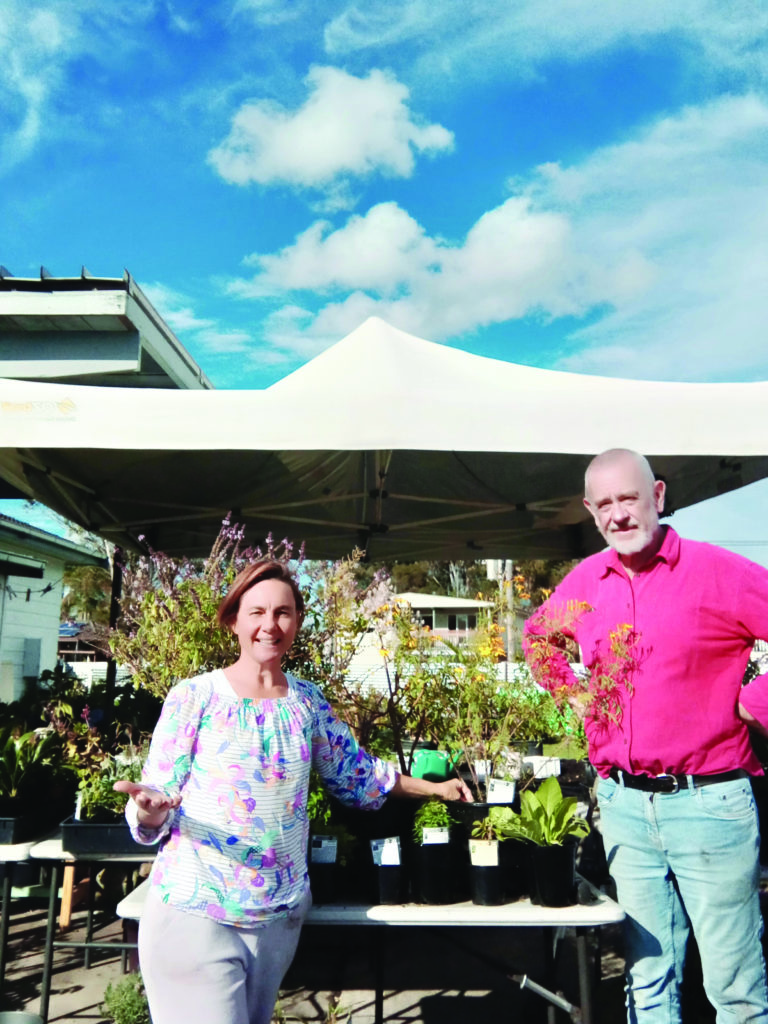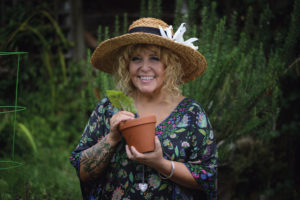You might have limited space or be renting but still want a lush and productive edible garden.
One solution to consider is growing your veggie garden in pots.
Other reasons you may have, include the ease of maintenance a potted garden can provide, being able to make your plants more accessible and it is also a wonderful way for beginners to start growing edibles slowly while getting their heads and hands around the basics.
The growing conditions can also be controlled with the ability to move pots to different locations throughout the day, seasons and year to better suit them and to create micro-climates by grouping them closely together.
If the soil is a concern to you in your area, by planting in pots you can avoid it altogether.
A Potted Herb Garden
I don’t think there are many herbs that you couldn’t grow in pots, but these are a few that you definitely can grow without any real issues: Basil, chillies, chives, coriander, mint, oregano, parsley, rocket, rosemary, sage and thyme.
Why don’t you also try growing ginger (Zingiber officinale) in pots?
Slow growing but so worth dedicating a pot or two to the cause.
Ginger grows from rhizomes, that’s the part you eat, and you can use organic ginger that has budded, or you will find that ‘planting’ rhizomes are fairly easy to obtain from suppliers online.
Minimum pot size is 30cm wide and make sure it is deep.
Into this, plant a 3cm piece with a growth bud to a depth of 5cm.
If you have a larger container, the spacing will be 20cm.
Your ginger needs a fun sun, warm position and you must use the best quality potting mix and keep it moist.
Feed with an all-round liquid fertiliser fortnightly.
Ginger is ready to harvest in about 8 months, once the foliage dies back.
When that occurs, empty out the pot and collect your spicy, delicious ginger!
Potted Veggies
A few vegetables that will grow successfully in pots include broccoli, bok choy, cabbage, capsicums, cauliflower, celery, cucumbers, eggplant, kale, lettuce, silverbeet, spinach, tomatoes, beans, peas, snow peas, squash, carrots, garlic, potatoes, radish and zucchini.
Beetroot is a vegetable garden favourite that does double-duty as the leaves are incredibly sweet and tasty and the beet is a prize either roasted, juiced or pickled.
A heavy feeder, so you will need to ensure a moist soil and fertilise with a complete all-purpose mixture each week, but the return is home grown beetroot which is divine.
You will need a large pot, at least 40cm wide with excellent drainage and top-quality potting mix.
Place in a full sun position.
Plant seedlings according to their type and seeds need to soak in water for a few hours before planting.
Snip off outer leaves to use as needed and harvest beetroots while they are young as they are sweeter.
Orchard of Pots
A moveable fruit farm is appealing to a lot of people, and everyone can have at least one of their most used or loved edible fruits in a pot including apples, apricots, blueberries, cherries, lemons, limes, mandarins, oranges and peaches.
Why don’t you plant some strawberries?
Firstly, make sure you have a self-pollinating variety and get a little creative because strawberries love growing in hanging baskets, window boxes and interesting containers that support their cascading habit.
They need lots of sun, a warm position, top quality potting mix and a potassium rich feed when fruiting or in a growth phase.
Simply pot up the young strawberry or crown in a pot at least 30cm, keep soil moist and wait for the berries.
Types of Pots
There are countless ready to use pots that you can find at local nurseries and even online.
Another consideration is to look at what you can recycle.
As long as the materials are non-toxic and it has adequate drainage, then you can grow your potted garden in it!
Be mindful of treated timbers, lead-based paints or toxic metals as these can all leech into the soil and then into your edible plants.
A few fun and planet-saving options include old wheelbarrows, baths, sinks, buckets, crates and cans.
Other crops in pots to consider are Australian native foods including warrigal greens (Tetragonia tetragonioides), finger lime (Citrus australasica) and midyim berry (Austromyrtus dulcis).
You will need a specialist native potting soil and fertiliser, but they are rather easy to grow in pots.
You will face similar challenges with all your crops in pots as you would growing in the ground such as pests and disease and there is no difference in the solutions for most of these.
Additional issues will be caused by inadequate drainage, incorrect position, inferior or incorrect soil or the overuse of full-strength fertiliser.
Down in Your Garden: Ebbin and Ian, Medicinal Herbal Garden
Ebbin and Ian began their small medicinal plant nursery in the middle of a pandemic, and when an economic crisis was looming, because they wanted to give to the community a feeling of hope and health.
They grow medicinal herbs, unusual plants and exotic trees in their San Remo gardens and have a passion to bring both the experience of the garden and its botanical treasures to others.
“Our first love has always been medicinal herbs for health & healing, but we also sell culinary herbs both the standard and exotic ones as well. Within the nursery are the insect repellents, exotic fruit trees and a bush tucker tree.” Ebbin enthusiastically tells me.
“All our plants are useful in one way or another” says Ian “medicinal, culinary, repellents or edible fruits”.
After 15 years of selling plants in three different states they are now settled in San Remo and are regularly seen at local markets.
I love their simple market signage; ‘Edible Plants’ as it describes their commitment to making the most of their garden for themselves and others.
They grow and sell basic medicinal herbs such as Feverfew, Brahmi, Gotu Kola, Plantain, Mugwort and Yarrow are represented alongside the less common Cinquefoil, Balm of Gilead, Butchers Broom, Mother of Herb, Wall Germander and the ever-popular Tulsi (sacred basil).
Rare culinary herbs include Saw Tooth Coriander, Horseradish and Moringa.
“The Moringa trees in particular have been very popular with many nationalities, local Philippinos, Fijians and Indians have flocked to our nursery, which has brought us together for a mutual sharing of wisdom” Ebbin says.
“Over the years our customers have shared with us their homeland experiences and knowledge of their traditional herbs and trees which has broadened our understanding of plants and their uses.
“Our plants are now enjoying the mild winters of San Remo, after several years in Southern NSW and Southern Victoria.”
She informs me, “We are currently preparing and planting for the spring season which is always the busiest time of year for plant nurseries.
“We are now constructing new seed raising facilities for the next crop of herbs.”
As well as finding this herbal gardening duo at our local markets, they also hold herbal workshops where you can learn more about the magic of medicinal herbs and you can also get hands on experience in the nursery with work exchange days which are an interesting way to go deeper while getting your hands dirty and opening your heart to health.
Ebbin and Ian know that just being out in the garden brings health and they have created a place of tranquillity in San Remo with their garden of medicine and food.
See more at HerbalHeartland/Facebook. Email: ebbinflorencebusiness@gmail.com (m) : 0412361092
PLANT HAPPENINGS
We can’t go anywhere my garden-loving friends, but we can keep in touch with others online.
Here are a few Central Coast Garden Groups and Pages with online communities that might interest you and if you have one, please let me know.
Central Coast Gardening Buy/Swap/Sell: facebook.com/groups/447192182028874
Central Coast Community Garden Network: facebook.com/CentralCoastCommunity
GardenNetwork
Permaculture Central Coast: facebook.com/Permaculture-Central-Coast-Inc-144426662325404
Australian Plants Society Central Coast: facebook.com/groups/APS.Gosford
THIS WEEK YOU COULD PLANT
Your annuals are going to benefit from a feeding of liquid fertiliser every fortnight at the moment and it’s hydrangea pruning time as well.
If you are wanting to change their colour, now is also the time – it’s all about changing the pH level of the soil and this can be done by adding aluminium sulphate to obtain more blue shades or lime for pinks.
You could plant artichokes, asparagus crowns, beetroot, broad beans, cabbage, carrot, English spinach, lettuce, mustard, late season onions, parsnip, peas, potatoes, radish, rhubarb crowns, salsify, silverbeet, English daisy, delphinium, dianthus, gloxinia, gypsophila, marigold, roses, spider flower, statice.
Cheralyn Darcey is a gardening author, community garden coordinator and along with Pete Little, hosts ‘At Home with The Gardening Gang’ 8 – 10am every Saturday on CoastFM963
Send your gardening questions, events and news to: gardeningcentralcoast@gmail.com





